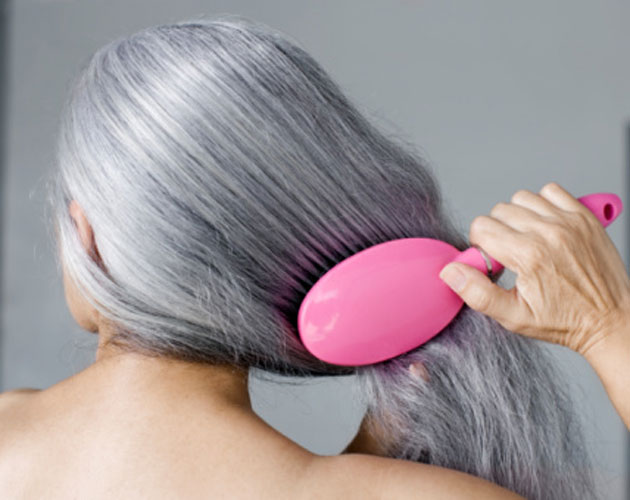Solve Winter Hair Woes

Dry, lack-luster locks, breakage, static and itchy scalps are just a few troubles of the season. Here, some healthy habits and tips to keep your tresses looking their best.
Go gently. Hair tends to be drier and more brittle this time of year, and thus more prone to damage. Take it easy with the hairbrush and styling tools, and use caution with hairpieces and extensions since they can pull on your hair and scalp. If you have long hair, pulling it back too tightly and for too long can cause damage and hair loss. Generally, the less you do to your hair, the better off it will be.
Still think you need to 100 strokes a day to keep your hair healthy? It’s a myth, experts say, and will cause more stress and static.
Wear a hat. A hat or headscarf will shield your locks and scalp where earmuffs and headbands leave you vulnerable to the ravages of the wind, cold and sun.
Worried about the dreaded “hat head”? Push or pin your hair back before you don the cap — but in the opposite direction to your style. If you’re worried about damaging or pulling on your hair, sew in a silk or satin liner.
Eat well. Hair needs nourishment from the inside, too, because what we eat becomes the foundation for new hair and nail growth. According to WebMD, certain deficiencies — like B-vitamins, essential fatty acids and protein — will have a detrimental affect on hair. Crash diets are even worse because they can rob your body (and hair) of vitamins, plus they can stunt and disrupt normal hair growth.
The good news is that a balanced diet that includes plenty of protein, vitamins and iron will help support scalp health and hair growth. Top foods you should eat include salmon, beans, dark green vegetables, nuts, poultry, eggs, whole grains, oysters, carrots and low-fat dairy products.
Get a trim. A trip to your stylist every 4-6 weeks will help to prevent split ends and breakage. Left untended, split ends can travel up the hair shaft and do even more damage.
Refresh your colour. The faded pigments of treatments gone by and light summer hues may make your skin look washed out in winter. If you love your highlights, try including a darker “low light” to keep your hair from having that bleached-out summer look.
If you’re worried about “frying” your hair, take heart: a complete colour job isn’t necessary. Try a glaze or rinse to brighten your hair instead.
Choose the right conditioners. Think your hair needs a good deep conditioning treatment? It depends on your hair type. Experts recommend a spritz of a conditioning spray for fine hair because it won’t weigh down it. If you have thick, heavy hair a deep conditioning mask is most appropriate. Either way, give your hair a little extra conditioning once a week to keep it in top shape.
Winter is also a good time of year to try a leave-in conditioner (if suitable for your hair type) to help provide some weight and control.
Swap products. Just like skin, hair is different in the winter, so why use the same products as in the summer? For example, beauty experts suggest a styling cream instead of gel to add moisture and elasticity so your hair is less likely to break. Still using a plastic or silicon brush? Try a natural boar bristle one or a wooden comb instead to distribute oils and prevent static.
What should you avoid? Anything with harsh chemicals or alcohol — they’ll dry the hair out.
Raid the pantry. Need a quick fix? Get out the oil. Some experts suggest rubbing a little vegetable or coconut oil between your hands and smoothing it on dry hair to give it a little boost of shine and moisture when needed. Be sure to start with a small amount (you can always add more), and start at the ends of your hair.
You can also use olive oil to make your own hot oil treatment. Drizzle some olive oil on your hands, rub them together to warm it up, then massage into your hair and scalp. Wrap your head in a plastic bag or shower cap, and cover with a towel to keep the heat in and help the oil penetrate your hair. After 20-30 minutes, simply rinse it out with a good shampoo. (See The do it yourself spa and European beauty secrets for other hair ideas from your cupboard.)
Stop static. Keeping your hair healthy will go a long way to help prevent static, but if you need a little extra help, many sources recommend keeping some dryer sheets on hand. Run one over your hair for a quick touch-up when needed. Anti-static products sprayed into your hat can help prevent that “recently electrocuted” look when you take it off.
Talk to a professional. Some changes are normal — but others aren’t. Any unusual dandruff (like large, yellow flakes) or hair loss (like suddenly losing hair or bald patches) should warrant a trip to the doctor. Dermatitis, fungus and other conditions can be easily treated, but some hair-related symptoms could signal other problems — like thyroid issues.
Sources: WebMD, About.com